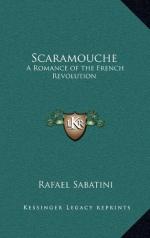|
This section contains 145 words (approx. 1 page at 300 words per page) |

|
Sabatini considered verisimilitude to be a central feature of good historical fiction and went to great lengths to develop his skill in this area. He was fond of trying to convince the reader that what was being presented was history, not fiction. He frequently cites fictitious references. For instance, in Scaramouche, Sabatini quotes letters that Andre-Louis wrote and he mentions a book the character wrote called his Confessions. The Sea Hawk (1915), supposedly, is taken from "eighteen enormous folio volumes" of history written by Lord Henry Goade.
Another of Sabatini's favorite techniques, one he freely admits he learned from Dumas pere, was to mingle real characters with fictional ones, actual events with created ones, in order to blur the distinction between fiction and history. So Mirabeau, Robespierre, and Danton — all architects of the Revolution — appear on Sabatini's stage.
|
This section contains 145 words (approx. 1 page at 300 words per page) |

|




